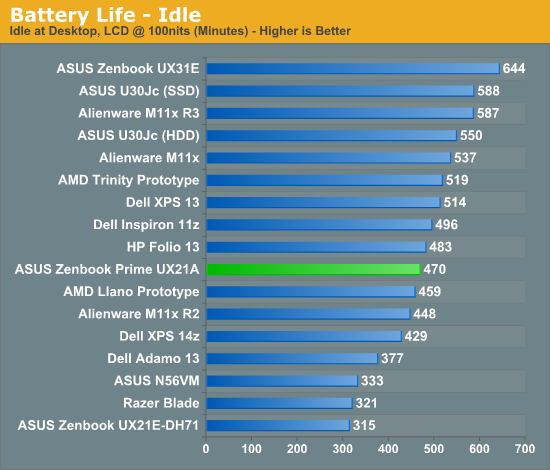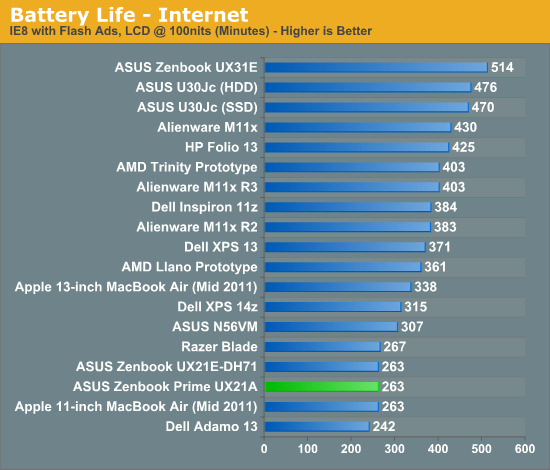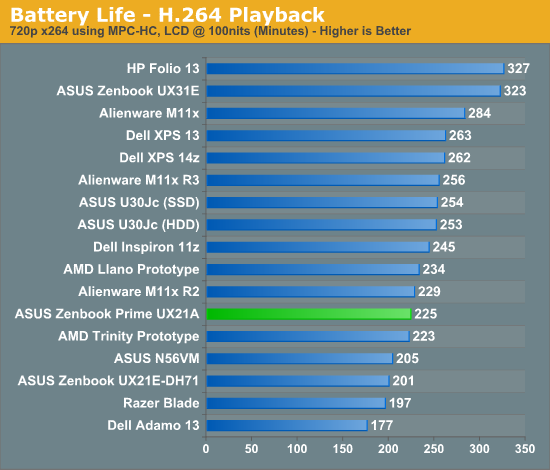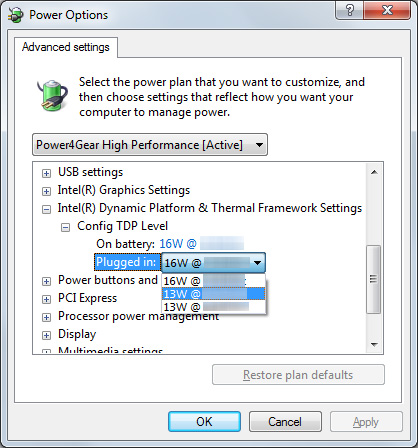ASUS Zenbook Prime (UX21A) Review: The First of the 2nd Gen Ultrabooks
by Anand Lal Shimpi on May 22, 2012 2:46 PM EST- Posted in
- Laptops
- CPUs
- Asus
- Ivy Bridge
- Zenbook
- Zenbook Prime
- Ultrabook
- Notebooks
Battery Life
Generally speaking, the 11-inch Zenbook Prime delivers about the same amount of battery life as its predecessor. For some reason we're able to hit much longer idle battery life on the Prime than the original Zenbook although I'm still trying to find out why. There's also an 11% improvement in our x264 playback test, but on average I'd expect to see similar battery life to the Sandy Bridge model - just with better performance. Note that these results also come despite the fact that ASUS is driving a much higher resolution, and presumably higher power, display than the original Zenbook.



The Zenbook Prime bucks the trend Jarred saw with the first Ivy Bridge notebook review where battery life took a small step backwards. These results bode well for future Ivy Bridge notebooks and Ultrabooks. It still remains to be seen if Intel's 22nm process will actually give us a battery life advantage in any notebook compared to its predecessor. It's possible that we are seeing some of the benefits of 22nm here already and they are simply offset by the more power hungry display. With the move to 22nm Intel should have a better hold on active power and leakage, but it's always possible that we'll have to wait until Haswell for the process to really be exploited.
Just like last time, ASUS has a couple of widgets to quickly change between power settings. The instant on widget lets you switch between suspend to RAM and suspend to disk modes. The former is expected to deliver up to 2 weeks of standby battery life, while the latter can push up to 150 days. I didn't have the time to test these claims (life is short, I draw the line at spending it testing claims of 150 day standby battery life). ASUS once again includes a counter that estimates how long your system will last in either mode based on current charge levels and power usage.
The next widget is a quick tool to let you switch between high performance and battery saver Power4Gear power profiles. You can customize these profiles via the Windows control panel, but it's nice to have a button on the desktop that lets you quickly switch between them.
Configurable TDP
One feature of Ivy Bridge that we haven't been able to test until now is configurable TDP. While most Ultrabook CPUs ship with a 17W TDP, that's mostly an arbitrary thermal/power rating. If an OEM wants to design a chassis that can only accept a 13W part it previously had to hope that Intel would make such a thing. Alternatively, the OEM could underclock/undervolt a 17W chip on their own and hope to mimic Intel's validation and deliver a 13W configuration of their own. The former requires that a significant number of OEMs demand the part, while the latter is just too risky for the larger OEMs (get too aggressive on the undervolting side and end up with a bunch of unstable systems). The solution Intel proposed with Ivy Bridge is configurable TDP. For Ultrabooks this means you can set a 17W part to 13W.

Currently the setting is hidden away in Windows 7's power management settings. Once again I've had to censor the clock speeds here due to Intel's Ultrabook embargo:
You can map the 13W settings to the battery saver profile and then, at the click of a button, have a 13W Zenbook Prime instead of a 17W model. The difference in performance isn't significant however:
| ASUS Zenbook Prime Configurable TDP Performance - Cinebench 11.5 (Multithreaded) | |||||||
| 16W - Max Freq | 13W - Mid Freq | 13W - Lowest Freq | |||||
| ASUS Zenbook Prime UX21A | 2.79 | 2.67 | 2.67 | ||||
I'm still running battery life tests to quantify the impact on power consumption, but it's conceptually a neat thing to see in action finally. I suspect configurable TDP is going to play a major role with Haswell and convertible/dockable Ultrabook-tablet hybrids.
Thermals and Noise
As with most high performance notebooks that are this thin, cooling is difficult. Under load the fans in the Zenbook Prime are definitely audible, but in general ASUS does a better job cooling everything inside the Zenbook Prime than Apple does in the MacBook Air. I suspect much of this boils down to how aggressive Apple is about keeping fan speed/noise down compared to ASUS' desire to maintain a certain temperature level inside the chassis.










192 Comments
View All Comments
Rasti1964 - Wednesday, June 6, 2012 - link
The lack of a gigabit LAN port is a killer for me too. A gigabit to USB 3.0 adapter would be the solution but: Where to find such thing?I´ve searched the web for some hours now without success.
Could you please tell us how to get this adapter?
Saareem - Thursday, May 24, 2012 - link
"Just like last time, the UX21A comes with a sleeve case, VGA dongle and USB to 10/100 Ethernet adapter."I'm quite surprised how many actually fails to read that sentence. There is usb-to-ethernet connecter available for the Zenbook Prime and not-Prime in Zenbook accessories buy a small price and it come's with those ultrabooks for free. Perhaps you could find a usb-to-gigabit ethernet adapter somewhere, but routers having a gigabit-ethernet are still a little bit uncommon, so I don't see much point there.
Definately not a killer, at least.
Finraziel - Friday, May 25, 2012 - link
Ehm, I don't know if maybe you're in a different part of the world where gigabit routers are uncommon, but I've had gigabit routers for years and actually only bought one myself when they got cheap. Friends of mine had gigabit routers for years before that already. I'd think someone with the money to buy a zenbook prime can afford the 15 euro or so that I see gigabit routers for.Looking in our local pricewatch though (which is very complete usually), I find one usb 2.0 to gigabit connector, no usb 3.0 yet, and it's 30 euros.
I had to transfer quite a bit of media for a friend who went to work abroad for a few months and would have very limited internet access last weekend, so I put a lot of movies and stuff on his laptop, but hadn't realised in time that it didn't have a gigabit port. Unfortunately that meant I couldn't put all that much on it in the time we had... when you're used to gigabit, not having it is severely limiting. I expect this would also be something that would annoy me, even if it would probably be one of the only things that would annoy me on this great machine.
Freddo - Tuesday, May 22, 2012 - link
I wish ASUS released an Intel Atom Zenbook. High quality form factor with an energy efficient CPU that allow for a 100% fanless computer. I don't really need that much performance from a portable computer anyway.phoenix_rizzen - Wednesday, May 23, 2012 - link
There's no ION chipsets for Atom anymore, and the IGP in Atom sucks balls worse than even SNB IGPs, so there's no way it would push a 1920x1080 display with any smoothness.Atom is dead, and should be buried.
jpk - Saturday, May 26, 2012 - link
Amen to that.Freddo - Sunday, May 27, 2012 - link
The Cedarview Atoms are perfectly capable of 1080p video playback, which is probably the most advanced thing I would use them for anyway. I'm not exactly looking into playing Crysis here, it's a small portable chat/surf computer, nothing more.vegemeister - Friday, June 8, 2012 - link
The Atom GPU is a PowerVR thing with really crappy proprietary drivers. Do not want.mooninite - Tuesday, May 22, 2012 - link
I wish the Zenbook came with 6GB or 8GB of RAM. 4GB is actually limiting these days. I need to be able to run a Virtual Machine (VirtualBox) on my laptop at times. Plus games will demand more than 4GB.ASUS, people do more than web surf and face book on their laptops. RAM is cheap enough that it should barely creep into your bottom line if you offered a Zenbook with more RAM.
phoenix_rizzen - Tuesday, May 22, 2012 - link
The UX32 has a SO-DIMM slot and supports 6 GB of RAM (2GB onboard + 4 GB DIMM). And it has a discrete GPU to boot. :)